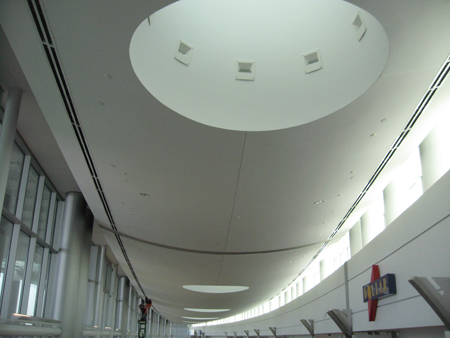
Photo courtesy of NWCB The ceiling in the Consolidated Rental Car Facility curves in three directions.
|
Location: SeaTac
Contractor: Expert Drywall
Architects: Callison, Demattei Wong Architecture
Team: Gypsum Wallboard Supply, Safway Services, Salmon Bay Construction Products, CertainTeed Gypsum, GC Products, Scafco Steel Stud Manufacturing Co., USG Building Systems
The Port of Seattle Consolidated Rental Car Facility’s fifth-floor main lobby ceiling was made from light-gauge steel studs. The ceiling is 412 feet long, varies from 13 to 38 feet in width, and curves in three directions.
In length, it follows the 1,086-foot radius window wall, and in width, the radius varies between 15 feet and 59 feet. It also has a radius in the long direction, with the elevation of the ceiling being 20.5 feet above the floor at each end, gradually sloping down to 18.75 feet at the center.
Expert Drywall framed the ceiling using metal studs and prefabricated radius track. The ceiling is supported from the underside of an elevated, fireproofed roof structure. The only attachment points for the support of the ceiling were the underside of the wide flange beams spaced 12 feet on center.
To add to the challenges of the curved framing, there were cone-shaped skylights, constructed with glass fiber reinforced gypsum, with varying radiuses integrated into the framing. Due to their size, weight and complexity, the skylights had to be supported by heavy-gauge steel-stud framing.
The steel-stud framing was sheathed with 5/8-inch Imperial board and finished with a smooth and continuous veneer plaster. The surface has architecturally located control joints in both directions, which accentuate the radius features.
Expert Drywall performed a substantial amount of pre-engineering, planning and coordination in order to accommodate the complex construction. BIM modeling and clash detection were extensively used to avoid conflicts with the above-ceiling mechanical, electrical and plumbing systems.
BIM modeling was also used to allow for each stud to be individually dimensioned and located, whether it was vertically attached to the beams, run horizontally or installed as a diagonal seismic brace.
The ceiling has been described as looking like the bottom of Noah’s ark or a very large football field hanging from the sky. Neither description truly captures the architect’s inspiration, which was the wings of very large commercial airplanes.
Judge’s comment: “The framed ceiling on this project is very simple and clean in appearance yet complicated in design and construction. This geometrical wonder brings a fantastic sensation to the overall facility.”